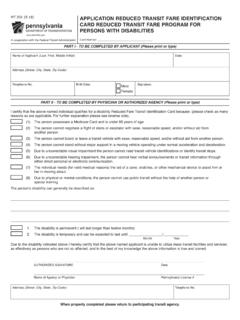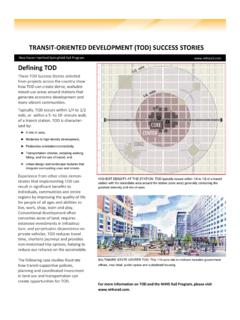Transcription of Boise Valley Streetcars
1 Boise Valley Boise Valley Boise Valley Boise Valley Streetcars and Interurbans Streetcars and Interurbans Streetcars and Interurbans Streetcars and Interurbans Boise Valley Railway Car No. 100. By Mark Moore The name Boise comes from the French word bois , which means "wooded." Many people assume that it means "tree", but the French word for "tree" is arbre, whereas the word bois means "wood" or "woods." One legend claims that the land that would become Boise , Idaho was discovered by a group of French-Canadian fur trappers in the early 1800s.
2 When the trappers came over the mountains and looked down from Bonneville Point upon the Boise River Valley , they exclaimed "Les bois!" (the woods!). Today, the city is still commonly referred to as The City of Trees. The Oregon Trail, a popular route running from Missouri to Oregon, brought many travelers through the area, increasing the need for trade and services in the town. A new fort in the Boise Valley was located adjacent to the settlement named Boise shortly after gold was discovered in the area in 1862. Boise was incorporated as a city within the Idaho Territory in 1864.
3 Idaho became a state in 1890 and a streetcar system opened in 1891. At that time, the area's population was about 88,000. 2 Streetcars on Main Street looking west toward the twin towers of the famous Idanha Hotel. Early view of Main Street looking east toward the twin towers of the Idanha Hotel. 3 Exterior view of Boise s Natatorium. The Boise City rapid transit Company opened one streetcar line on Main Street in 1891 with a passing track in front of the Belgravia. For a nickel, one could take the streetcar out Warm Springs Avenue to the Natatorium.
4 Interior view of the Natatorium. Boise began to grow and new subdivisions sprang up around town. Additional miles of track were laid to reach the newer parts of town. Then in 1905, construction began on two new lines designed to connect Boise , Nampa, Caldwell and the surrounding areas. The Boise Interurban Railway, which was the northern extension of this loop system, connected the towns of Eagle, Star and Middleton along the Boise River. Service to Caldwell began on August 16, 1907. 4 Interurban car at Star, Idaho. Inaugural run of the Boise -Caldwell interurban car at Caldwell in 1907.
5 Meanwhile, Boise Valley Railway was laying tracks up Fairview to Ustick Road, which it followed until the rail line curved south into Nampa. This line was later relocated through Meridian. A national financial panic halted construction in 1908, but local passenger service was added along Fairview to Cole School. Another branch went to Hillcrest and South Boise , where carbarns were located on Rossi, one block west of Broadway. A new depot was built in Boise at Seventh & Bannock. 5 Builder s photo of the Boise -Caldwell interurban car number 6 in 1907.
6 The interurban loop was completed through Meridian in July of 1908. Tracks in Meridian went west from the corner of Meridian and Pine Streets south to Broadway, east to East Third, north to Pine and west to the intersection of Meridian and Pine, forming a turnaround. A spur ran from Broadway and East Third Streets enabling the transfer from the Oregon Short Line (later Union Pacific) to Boise via the Boise Valley Railway Company. In 1912, the Boise Valley Loop was completed, allowing passengers to ride the 70-mile loop between Boise and Caldwell.
7 Both systems became part of the Idaho Railway Light & Power Company in 1912. Students at the College of Idaho were frequent passengers on the line. 6 Early view of an interurban car along the Boise River near Caldwell, Idaho. One of the builders of the Boise Hotel, Walter Pierce, a pioneer real estate developer, established a recreation area at the western terminus of the Loop which he named Pierce Park. City dwellers in Boise could take the interurban loop for a weekend excursion to Pierce Park which later became Boise s Plantation Golf Course.
8 7 View of Pierce Park on the western edge of Boise . Facilities on the Loop included power substations at Pierce Park and Middleton, a large carbarn at Pierce Park, depots in Caldwell and Boise and many small stations and shelters at one to two-mile intervals along the route. City Streetcars were added in Boise on a loop called the belt line which ran north on Tenth and Fifteenth Streets to Dewey and back on Eighteenth. The Caldwell Traction Company began operation in 1913. It operated about 27 miles of track on two routes; south to Huston and McNeil, on to the Snake River at Marsing s Ferry with a branch to Lake Lowell (formerly known as Deer Flat Reservoir) and west to Wilder where it leased another branch of the Oregon Short Line and electrified the route.
9 The operation included both freight and passenger service, but the railroad had a very hard time staying profitable. When Caldwell Traction failed in 1920, the lease was cancelled and Union Pacific retained ownership of the lines. The bankrupt operation was abandoned in 1924. Meanwhile, the Idaho Power Company became the parent of the Boise Valley Traction Company and in 1916 there were 39 passenger and service cars with 70 miles of track west of Boise and 13 miles of track in Boise . In 1920, the Boise Valley Traction Company had its best year.
10 The cars had logged over a million car miles and they carried more than two and a half million passengers. Over the next few years, passenger and freight service declined and on May 17, 1928, all operations ceased. The rolling stock was scrapped. The Boise Valley has continued to grow, located in the center between Salt Lake City and Portland. The Boise area is now the third largest metropolitan area in the Northwest and as it grows, it is again considering bringing Streetcars to Boise streets with a planned 2-mile stretch of track downtown and a later extension to Boise State University.







